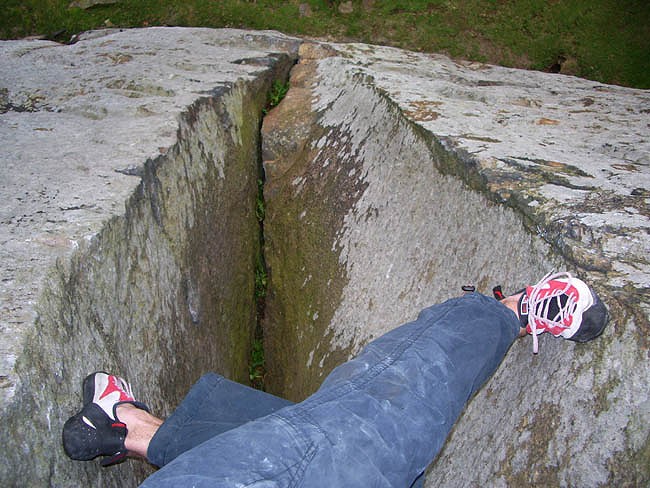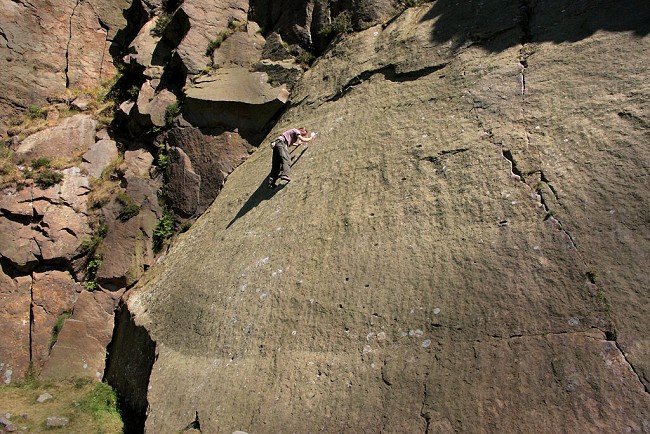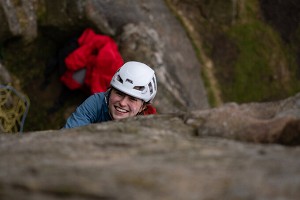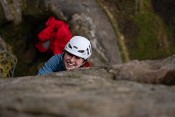
"You know," said my friend Peter, as he belayed me up, "you're really not using your feet well at all." Instant deflation, which also left me perplexed: how could he say that I wasn't using my feet well if I was getting up the pitch?
Most beginners, certainly men, are terrible at using their feet well, and some never learn how. The key to improvement is usually seeing someone who is very, very good climbing: if you watch them getting up something where you can't even see what they're standing on, you quickly realise that footwork can make a very big difference.
Fact: the difference between ordinary climbers and top climbers is footwork, not big arms.
The week before I was on The Plum, I was at Millstone watching someone who had just led Time For Tea (E3 5c) having a go toproping Scritto's Republic (E7 6b). What amazed me was the precision with which he placed his feet - more specifically, how he looked at just where he was going to put his toe and the edge of his foot, and then put it right there. No scraping or scrabbling; he just put his shoes on the rock and stood on the spot he had chosen.
It's very hard for beginners to understand that your footwork is the key to improvement. But think of this: remember the difference it made when you first put on a pair of climbing shoes, rather than trainers? Suddenly your feet would stick to things you never could have dreamed of with normal shoes.
The precision and sensitivity that good climbers bring to their footwork, wearing the same shoes as you, is the same as that between wearing trainers and rock boots. They're much more aware of the signals coming from their feet, of how well their feet are sticking, and they take more care about where they put them. Whether you climb 4c or 5c, don't forget that there are people who can do 6c, 7a or maybe even 7b moves - and most of their weight is taken by their feet. That's a lot better than you're doing presently - but honestly, they're not superhuman. Nor do they have different rubber from you - Seb Grieve climbed Parthian Shot (E9 6c/7a) in a pair of Five Ten Velcros, the same model you can see at crags and climbing walls all round the country.
So, you're thinking, how can I tell what's wrong with my footwork? And how can I improve it?
Diagnosing what's wrong is tricky. It can help to get a friend to watch you. (Take it in turns on each other - that way you can hurt each other's feelings equally.) Clues include:
Because your legs are much stronger than your arms, you should always try to get your legs to take the overwhelming majority of your weight. Always try to maximise the force that you put through your feet - though be sensitive to marginal holds. Make sure your boots are tight: sloppy boots mean sloppy footwork, because you can't push precisely on holds.
Look down at what you're going to put your foot on. The most common fault beginners make is to stand and look up for handholds, and vainly try to move their hands up while standing in the same place. It never works and leads to desperate lunges. Instead, get comfortable on the handholds you have, and then look to see what footholds are available so you can step up. Ask yourself as you look at the footholds: is that the best hold? How do you have to direct your weight to use the hold best?
Many people (especially at climbing walls) don't believe that sloping holds will take their weight. Usually they will (often better than the same hold used as a handhold). What puts people off is that their foot slips off the hold initially.
This makes many beginners reluctant to trust small or sloping holds - they put their foot unweighted on it, and it seems to want to slip off. But your shoe rubber can only stick to a hold once you exert force on it. This is why rockovers and smears can seem perilous until you get used to the principle that you have to transfer weight onto the higher foot: for rockovers, shift your weight sideways towards the higher knee; for smears, consciously think about pushing on the wall with your smearing foot.

Aim for precision too. As the top climbers show, it's control over your feet which makes a difference. Tim Emmett once described being in a heightened state of mind on a day when he soloed Left Wall (E2 5c) and Right Wall (E5 6a) at Dinas Cromlech: "I could just see the little pebbles and screw my toe on them and know exactly that they were going to stick," he said. Notice that he didn't talk about the handholds; hands are for balance, and on the Cromlech using your feet to the maximum is essential to stop yourself pumping out. And if you're soloing, then the importance of not pumping out is obviously a lot higher.
If you want to improve your footwork quickly then doing lots of gritstone and limestone slabs is an excellent way forward. But vertical faces and even overhanging rock are good too; on overhanging ground it actually becomes more important to use your feet precisely, both to save strength in your arms on each move and to get you through the physically wearing parts quickly, before you tire too much.
Slabs however give you more time, because your arms aren't at risk of pumping out, in which you can listen to what your feet are doing, and try to sense - with your eyes closed if you can (though perhaps this is better done indoors) - how shifting your balance controls the weighting on your feet, and the way that affects the usability of a foothold.
Practise using smaller footholds when you're training. When you're warming up you should use large footholds until your arms and fingers are warm, but try then to give yourself harder problems. If you use small footholds then you will put more strain on your arms, but you should also aim to extract the most help from those footholds too. Sometimes it's effective to have one foot high so that you can let most of your weight rest on one foot; other times you'll just have to invent ways to get the weight off.
If there's one piece of advice that would make most mid-grade men climb better, it would be: try to climb like a woman. Because they don't have the height or the big shoulder muscles, women have to climb more efficiently, using their feet to get them higher. This is just as true on difficult traverses and roofs: men think it's all about muscle, but "weaker" women will often outshine them. The best solution, then, is to watch out for women climbing next time you're out, and try to copy them.
Well, at least it gives you a good excuse.....

















Comments